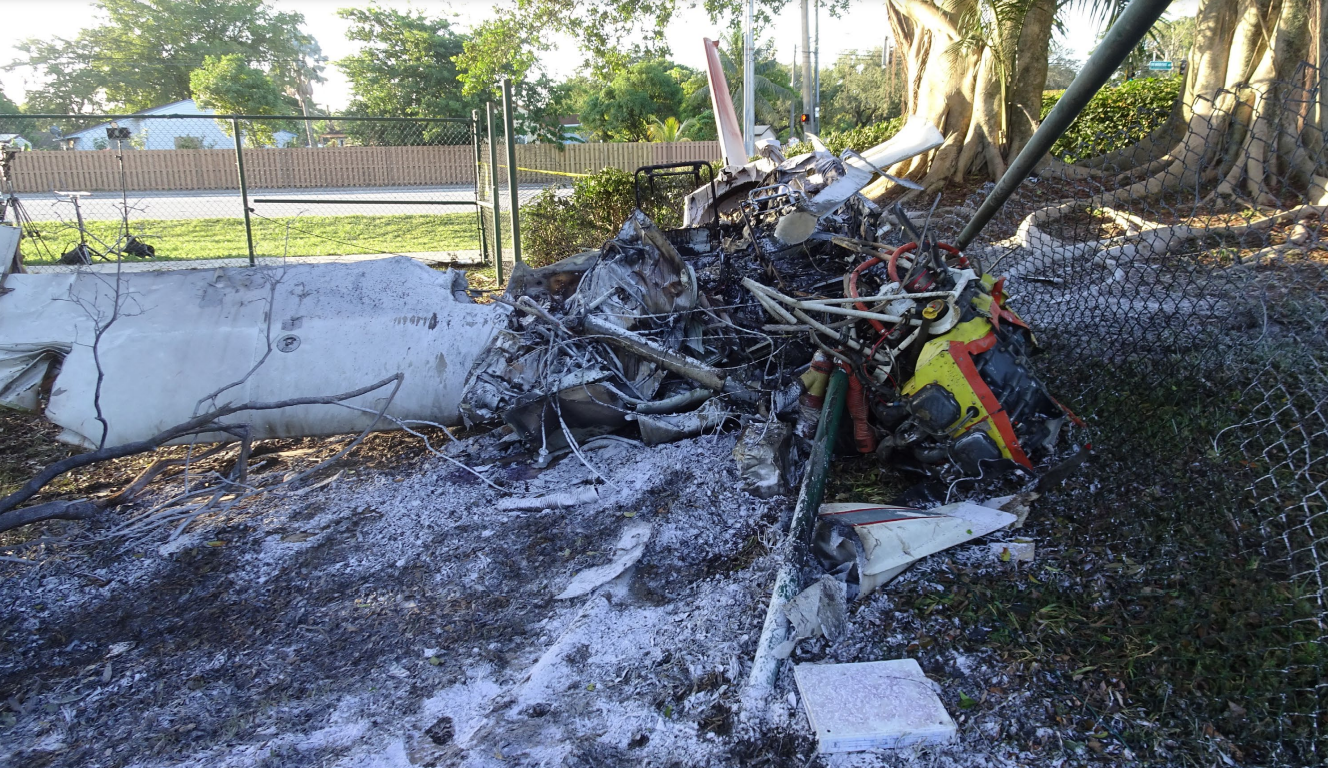
ASN Wikibase Occurrence # 245805
This information is added by users of ASN. Neither ASN nor the Flight Safety Foundation are responsible for the completeness or correctness of this information.
If you feel this information is incomplete or incorrect, you can submit corrected information.
| Date: | Thursday 17 December 2020 |
| Time: | 16:37 |
| Type: |  Socata TB10 Tobago |
| Owner/operator: | Octopus Flying Club Inc |
| Registration: | N5547Y |
| MSN: | 1246 |
| Year of manufacture: | 1991 |
| Total airframe hrs: | 2174 hours |
| Engine model: | Lycoming O-360-A1AD |
| Fatalities: | Fatalities: 1 / Occupants: 4 |
| Aircraft damage: | Destroyed |
| Category: | Accident |
| Location: | North Perry Airport (HWO/KHWO), Hollywood, FL -
 United States of America United States of America
|
| Phase: | Take off |
| Nature: | Private |
| Departure airport: | Hollywood-North Perry Airport, FL (HWO/KHWO) |
| Marathon-Florida Keys Airport, FL (MTH/KMTH) | |
| Investigating agency: | NTSB |
| Confidence Rating: |
On December 17, 2020, about 1637 eastern standard time, a Socata TB10, N5547Y, was destroyed when it was involved in an accident near Pembroke Pines, Florida. The pilot and two passengers were seriously injured, and one passenger was fatally injured. The airplane was operated as a Title 14 Code of Federal Regulations Part 91 personal flight.
The pilot was initiating a cross country flight with three passengers on board. After performing an engine run-up that included a functional check of the carburetor heat and verification of full static rpm, he waited 8 minutes for his instrument takeoff clearance with the engine operating about 1,200 rpm. After being cleared for takeoff, he taxied onto the runway, applied full throttle, and began his takeoff roll. One pilot-rated witness, who was also an airframe and powerplant mechanic, reported hearing a loud noise that he described as a “definite hard miss,” and a second pilot-rated witness reported hearing “popping and banging” throughout the airplane’s takeoff. The pilot reported attaining a normal takeoff distance, which would have been about 1,135 ft according to performance calculations; however, the second witness noted the airplane rotated about 1,542 ft down the 3,350-ft-long runway.
After rotating, the pilot pitched for 73 knots, and at 100 ft, he reported the airplane would not climb. The airspeed started to decrease, which resulted in the stall warning horn sounding. With a significant loss of engine power, he attempted to maintain 70 knots but was unable, and he made small pitch adjustments to stay above 65 knots, eventually retracting the flaps. Unable to maintain altitude, he maneuvered for an off-airport forced landing during which the airplane impacted a tree and then the ground. A postcrash fire erupted. The pilot exited the burning airplane but returned to rescue the right front and left rear seat passengers (both minors) who were unable to release their restraints for undetermined reasons.
Although the pilot reported the fuel selector was on the right fuel tank, it was found selected to the left fuel tank; however, this likely did not contribute to the partial loss of engine power as both tanks were fueled before the flight. Examination of the engine, engine systems, and the remains of the left and right fuel supply and vent systems revealed no evidence of any preimpact mechanical malfunctions or failures that would have precluded normal operation.
The atmospheric conditions at the time of the accident were conducive to the development of serious carburetor icing at glide power. Given the evidence, it is likely that following the prolonged wait with the engine at a low power setting before takeoff, the engine developed carburetor ice during the subsequent takeoff, which resulted in the partial loss of engine power during takeoff.
Although the pilot reported a normal rotation point, the witness-reported rotation point and onboard recorded data showed the airplane’s takeoff roll was between 34% to 41% longer than the calculated takeoff roll distance for the environmental conditions that day. The longer takeoff roll and the abnormal engine noises reported by the witnesses should have alerted the pilot to the partial loss of engine power and prompted him to abort the takeoff, which would have avoided the accident.
Probable Cause: The pilot’s failure to use carburetor heat in environmental conditions favorable for serious carburetor ice during a prolonged wait with the engine at a low power setting before takeoff, which resulted in a partial loss of engine power due to carburetor ice. Also causal was the pilot’s failure to recognize degraded engine performance during the extended takeoff roll and abort the takeoff.
Accident investigation:
 |
|
Sources:
https://www.nbcmiami.com/news/local/small-plane-crash-in-pembroke-pines-leaves-1-hospitalized/2346334/
https://www.sun-sentinel.com/local/broward/pembroke-pines/fl-ne-pembroke-pines-plane-crash-20201217-ianb7jdixvcm3o4eqik32uvmce-story.html
https://www.local10.com/news/local/2020/12/17/4-injured-when-small-plane-crashes-in-pembroke-pines/
https://www.nbcmiami.com/news/local/man-dies-from-injuries-suffered-in-december-plane-crash-in-pembroke-pines/2364592/
NTSB
https://flightaware.com/live/flight/N5547Y/history/20201217/2100Z/KHWO/KMTH
https://registry.faa.gov/aircraftinquiry/Search/NNumberResult
https://www.airport-data.com/aircraft/photo/000126729.html (photo)
Location
Images:


Photos: NTSB
Revision history:
| Date/time | Contributor | Updates |
|---|---|---|
| 17-Dec-2020 23:09 | Geno | Added |
| 17-Dec-2020 23:14 | Geno | Updated [Source, Damage, Narrative] |
| 18-Dec-2020 10:47 | The2ndBaron | Updated [Nature] |
| 17-Jan-2021 19:57 | Geno | Updated [Total fatalities, Source, Narrative] |
| 20-Oct-2022 19:24 | Captain Adam | Updated [Time, Aircraft type, Source, Narrative, Category, Accident report, Photo] |
| 20-Oct-2022 19:25 | Captain Adam | Updated [Photo] |
Corrections or additions? ... Edit this accident description
The Aviation Safety Network is an exclusive service provided by:


 ©2024 Flight Safety Foundation
©2024 Flight Safety Foundation